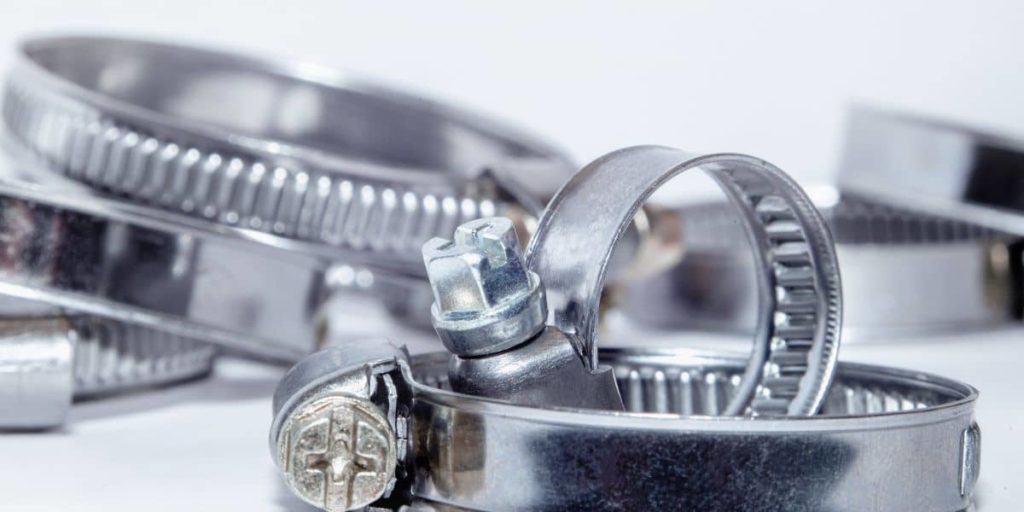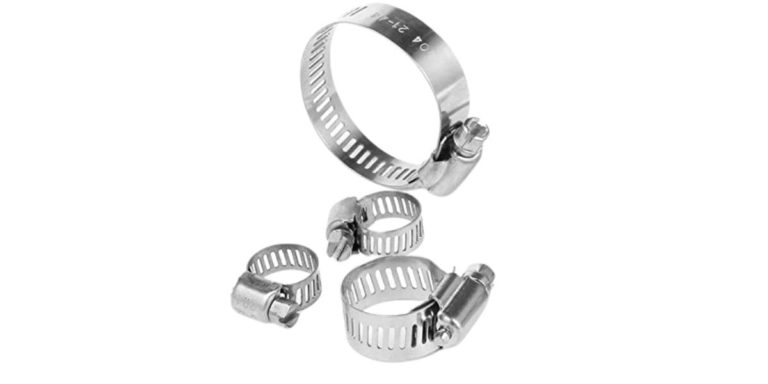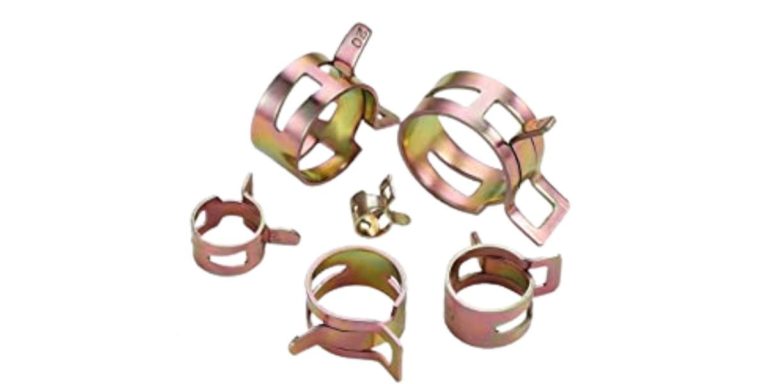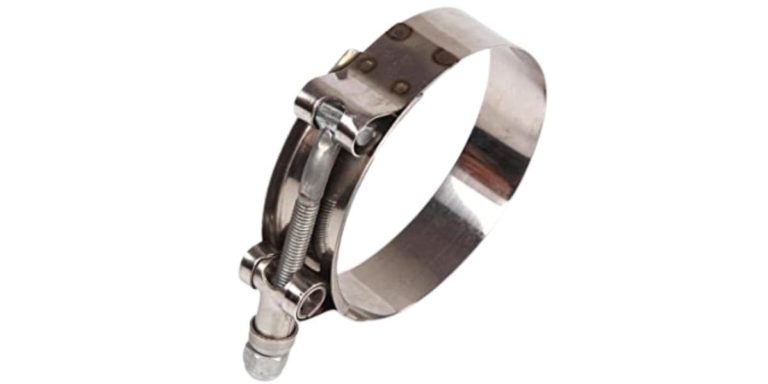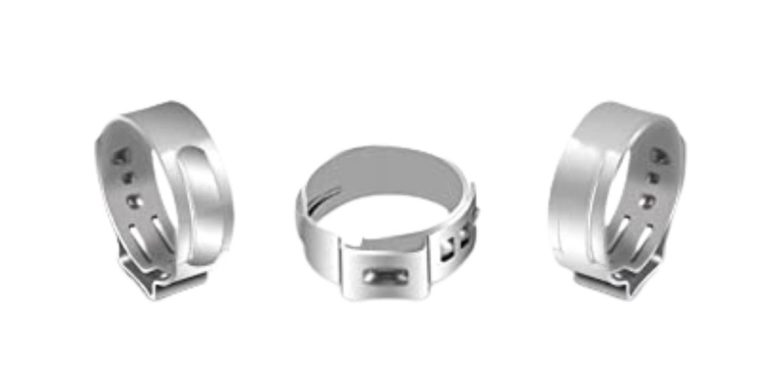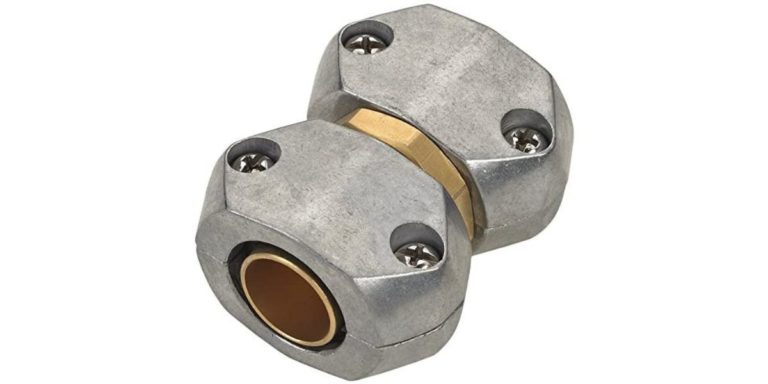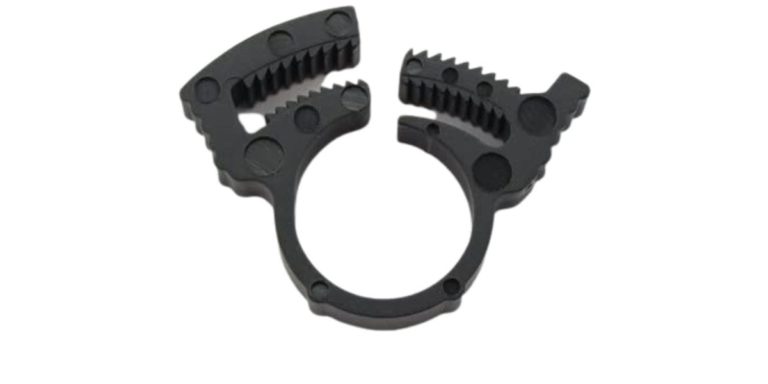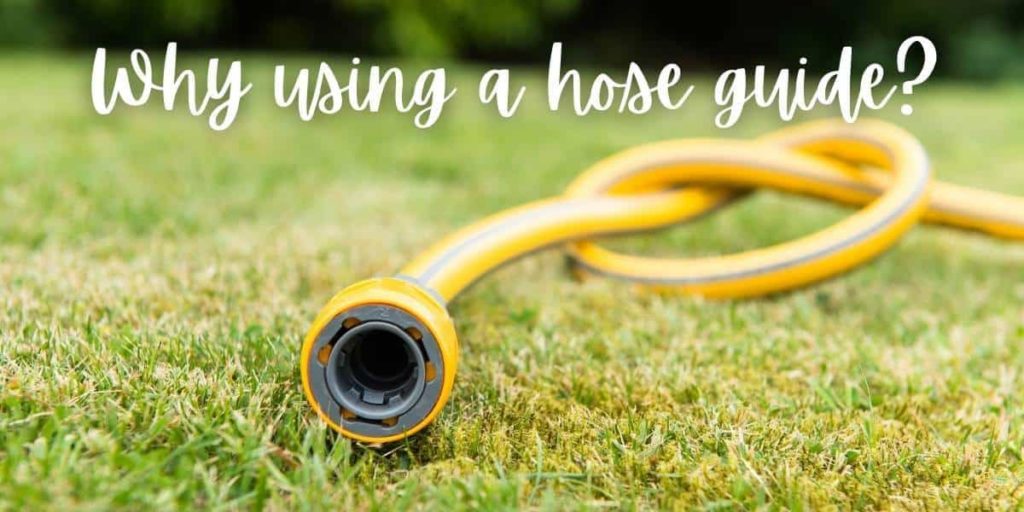One of the most important accessories you should have in your main gardening tool kit is a good set of hose clamps. You never know when you need one, but you will bump into a situation where the best quickest fix is covered by using hose clamps.
If you need to purchase hose clamps but don’t know where to start researching and how to choose the right ones for the job, this article may provide all the answers you need.
In this post, we detail the basics in terms of hose clamps and we will answer the most frequently asked questions. You will find out what hose clamps are, how many types of models are available, how to use them, how to choose the ones you need, and other important details. Make sure to keep reading all about it below!
Garden hose clamps are helpful in maintaining garden equipment and gardening. They can be found at any hardware store.
What is a Garden Hose Clamp?
A garden hose clamp is an accessory tool used to secure garden hoses onto different fittings or to the water source coupling, with the purpose of preventing water from leaking at the connection point.
In other words, a hose clamp ensures the flow of liquids through hoses or pipes without any leakages or spills. Hose clamps can be used in different fields, in all areas where we use pipes or hoses for the safe transportation of liquids or gas. So, you can find different models of hose clamps designed for the automotive industry, or that can be used in plumbing, agriculture, and more.
Most of the time we use garden hose clamps to secure hoses on one or both ends. In gardening, we often use hose clamps to either attach our garden hoses to the outdoor spigot, connect two garden hoses together, or fix a leaking garden hose.
The hose clamps can be made from either plastic or metal, and most types have a screw-on design. The garden hose clamp can be tightened by turning the screws at the end of the fitting until it reaches a desired level of tightness.
How do Water Hose Clamps Work?
Garden hose clamps are one of the most common tools used in gardening, so it can be helpful to know how to use them. Depending on the type you use, the installation is not a difficult job. For some models, you may need additional installation tools, like a hose clamp plier, for example.
All the hose clamp types work similarly. Once you attached the garden hose onto a fitting, wrap the hose clamp around the hose, towards the hose end. Then squeeze it until it is tight to the hose, manually or by using a clamp plier tool, sealing off any gaps that might let water leak out.
To be sure the hose connection is secured, turn on the water flow and check if there are any leakages. If needed, increase the clamp tightness onto the garden hose. But on the other hand, make sure to not overtighten the hose clamp as it can damage the garden hose in time, or it can have a negative impact on the water pressure that is delivered through/by the garden hose.
What Are the Different Types of Clamps For a Garden Hose?
There are several types of hose clamps, but they all have the same basic goal: to make it difficult for water to escape from the connection point. With so many options to choose from, selecting the proper hose clamp type is many times a confusing task.
Hose clamps are classified by their size, material, shape, and installation type.
Hose clamps by size
How do you know what hose clamp size you need? In terms of size, garden hose clamps are available in a wide range of diameters.
The size of a hose clamp is determined by its inside diameter which is measured in inches or millimeters (mm).
All hose clamps have a minimum and maximum diameter they can fit to. In order to choose the correct hose clamp size, measure the diameter of your garden hose and make sure the hose diameter falls in the middle of the hose clamp diameter range.
If you are still not sure which size is best in your case, consider choosing a cut to fit, Stainless Steel Hose Clamp Assortment Kit DIY.
Hose Clamps by Material
In terms of the material, they are made of, clamps can be either plastic, nylon, metal, galvanized, stainless steel, or other alloys.
Depending on the level of gardening that you are performing and how often you need to drag out your garden hose, different material clamps will best suit your needs
The metal alloys, brass, and stainless-steel hose clamps tend to last longer, and they are easier to tighten. But in some cases, depending on their coating, they can rust over time.
Plastic hose clamps are also durable, but they can be difficult to remove after usage.
Hose clamps by shape and installation type
Are all hose clamps the same? Well, in terms of shape and installation type, there are at least seven different types of hose clamps. We provide more details for each of these types below.
1. Screw Band or Worm Drive Hose Clamps
The worm drive hose clamps are one of the most frequently purchased hose clamp types. You can find them sold under different names, such as Worm Gear Band, Screw Clamps, Duct Pipe Metal Clamp Strapping, Hose Band Clamps, or Jubilee Clips.
The Worm Drive Clamps are very easy to differentiate from the other types of hose clamps. They consist of a metal band with a screw thread pattern inbuilt, and an attached screw that can be turned clockwise or counterclockwise.
The working principle is very easy. You need to insert the metal band on top of the garden hose and use a manual screwdriver to turn the screw clockwise. The screw will act like a worm drive and will tighten the metal band slowly to the garden hose, holding it in place. To remove the worm drive hose clamp, you need to turn the screw counterclockwise. It will then release the metal band and you can easily use it again when needed.
Therefore, the benefits of using worm drive hose clamps, or jubilee hose clips, are the easy and quick way of using them and the possibility of reusing them for a different task, if needed.
The Worm Drive Hose Clamps are usually made of an antirust, anti-corrosion material, for a longer lifespan. So, most of the models on the market are made of stainless steel.
If you are not sure which brand to purchase, we have selected our favorite four models to help in your decision-making process.
2. Spring Clamps
A spring clamp is a metal band circular shaped, but with the circle ends bent outwards. Each end of the metal band has protrusions. One end has a protrusion in the middle and the other end on the exterior sides. The protrusion ends of the spring clamp interconnect into a ring shape.
It is very simple to use and set up spring clamps, all you will need is a pair of standard pliers. Specific spring clamp pliers are available on the market, but you can also use simple pliers.
To use the spring hose clamp, do the following steps:
- Prepare your pliers and the spring clamps
- Press both bent ends of the spring clamp using the plier tool, to make the clamp open
- Attach the spring clamp onto the garden hose
- Loosen again the clamp using the pliers until you attach the hose to the barb fitting
- Release the spring clamp ends to hold the garden hose in place.
When choosing this type of hose clamp consider that spring clamps are a good choice for smaller diameter hoses and water pipes.
Spring clamps are most of the time made from spring steel, some models have a zinc plated coating for increased durability, but hard plastic versions are also available.
Spring clamps are very versatile and suitable for a lot of applications, such as fuel lines, gas or air pipes, garden hoses with smaller diameters, water pipes, etc. Spring clamps are reusable and available in different sizes. However, the diameter ranges that a size can be used for are smaller than in the case of Worm Drive Clamps. You will need to measure your water hose diameter to understand which spring clamp size will do the job.
Here are our top four options for spring clamps:
3. T-Bolt Hose Clamps
The T-Bolt Hose Clamps look more like the Worm Drive Hose Clamps. They consist of a ticker metal band, with no threaded pattern visible, a housing, and a screw. The band has a smooth underside and oblique edges, protecting the hose from damage. The bolt is directly engaged in the barrel and can be fastened manually, using a socket ratchet tool.
The T-Bolt hose clamp is easily adjustable and provides a 360 degrees seal. It is one of the best options for medium and heavy-duty hoses, and for higher PSI water pipes.
When comparing the T-Bolt Hose Clamps with the Jubilee Clips (Worm Drive Clamps) the T-Bolt Clamp does not damage the garden hose no matter if you overtighten them. These clamps are more effective and can ensure a totally leakproof seal that can last for years.
The T-Bolt Clamps have a limited adjustable range, just a couple of millimeters, and you will need to measure the diameter of your hose to know which size will fit it.
Same as in the previous cases, we have selected four T-Bolt Hose Clamps based on our own preferences:
4. Ear Hose Clamps
The Ear-Style Crimp or Ear Hose Clamp is a metal band with pre-shaped closing elements, which are known as ears. When the ears are closed with a hose clamp pincer tool or an ear hose clamp pliers, the band of the clamp gets tightened around the garden hose. An Ear Hose Clamp can have one or more closing elements, depending on the model.
This type of hose clamp is very easy to use. To set up an ear hose clamp just place it onto the garden hose then fix the garden hose to the barb fitting. Use an ear clamp plier to grab the ear or the closing element of the hose clamp and squeeze it until it gets tightened onto the hose and holds the hose in place.
These types of pinch clamps provide a 360 degrees seal and are very effective.
Once used, the ear hose clamps can’t be removed and used a second time. When selecting this type of hose clamps make sure to select the closest size to your garden hose. You will not have a high adjustable range, so it is better to get the most appropriate size for the job.
If you need some suggestions, here are our top four selection of ear hose clamp models and brands.
5. Wire Clamps
The Wire Clamps are heavy wire pieces that can be bent around a garden hose and turned until they tightly hold the hose in place. These types of hose clamps can be easily made from any heavy wire that you have around in your garage or shed. Alternatively, you can find them at any hardware store.
Another variation of this type of clamp is the Hose Cable Tie or the plastic collar, made of durable and flexible plastic. You can easily use a couple of these to hold a garden hose in place. These Cable Tie hose clamps are easy to use for a variety of purposes and at a very affordable price. The only downside is these can’t be reused, and when overtighten they might damage the garden hose in time.
6. Hose Mender Clamps
A Hose Mender Clamp is a simple three-piece unit that includes a mender and two mender caps that get connected with screws.
This type of clamp is usually made of hard plastic or galvanized brass, and it is reusable. The Hose Mender Clamps are usually used to fix a broken garden hose. Most of the models are compatible with both ½ and ¾-inch garden hoses.
The hose mender installation process is very easy:
- You need to cut the damaged portion of the garden hose making sure you are performing straight, 90-degree angle cuts.
- Attach both ends of the hose to the mender barb fitting.
- Arrange the two caps of the mender on top of the garden hose, making sure they are above the inserted hose coupling fitting.
- Tighten the 2 screws of the hose mender until the hose is held in place.
Here is our selection of hose mender clamps:
7. Nylon Double Bond Clamps
These Snap Ratcheting Clamps are available in many sizes and each size mentions the minimum and maximum diameter that they can hold. These types of clamps are made of nylon engineering plastics, corrosion-resistant, and more durable than normal plastic clamps.
The Double Bond Nylon Clamps have a ring shape with a double grip of teeth that gets interconnected once installed.
They are very easy to use and are reusable.
To install a double bond clamp, you don’t need any specific tool, you can manually set them up by following the steps mentioned below:
- Place the clamp over the garden hose
- Connect the barb fitting to the hose
- Squeeze the two sides of the double bond clamp until they interlock.
- Keep squeezing the clamp teeth until the garden hose is properly fixed
- Keep in mind that at least three of the clamp teeth must be interlocked to properly fix the clamp.
To remove the double bond clamp from the hose, push the two side teeth grips in opposite directions until they disconnect from the grip. Then you can reuse them for a different connection.
We have picked three different options of nylon double bond clamps, please check them below:
Is There a Special Tool for Hose Clamps?
As you can understand, in some cases you might need different specific tools for installing or removing your hose clamps.
The most frequently used tools for the installation or removal of a hose clamp are standard pliers, hose clamp pliers, manual screwdrivers, hose clamp pincer tools, and ear hose clamp pliers, or a socket ratchet tool.
If you decide to invest in a set of tools that can help you with this type of task, please check out our selection below.
Can I Reuse Hose Clamps?
Depending on the model you select, as detailed above, some hose clamp types can be reused.
Most often, the below types of hose clamps can be reused:
- Worm Drive Hose Clamps
- Spring Clamps
- Hose Mender Clamps
- T-Bolt Hose Clamps
- Nylon Double Bond Clamps
How Many Hose Clamps Do I Need?
In terms of how many hose clamps to have in your personal stock of hose garden accessories, we can’t predict a specific number. It is up to you as you would know best the level of gardening tasks that your water hose is used for and the likeliness of it getting damaged, disconnected, etc.
We always keep a couple of hose clamps available for immediate use, so that we won’t be caught on the wrong foot if our old hose clamps wear out or if we have some unpredictable issues with our garden hose.
Keep in mind that when you do a garden hose fix, for example, you will always need at least two hose clamps.
Conclusion
Even if all hose clamps are designed for the same purpose, holding hoses and pipes in place, the number of options available is constantly increasing.
In this post, we listed and detailed the most important types of hose clamps and described the installation steps for gardening use.
We recommend you return to this short guide whenever you need to buy, replace, or repurchase any type of garden hose clamps.
